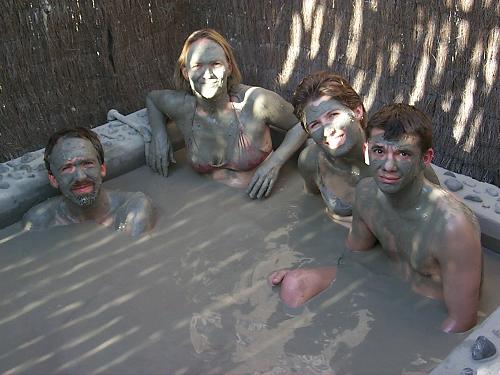Post Fourteen - Sheep and Hot Springs
 Sue, the Wonder Herder Sue, the Wonder HerderMeet Sue of Greg's Sheep-n-Show, a tourist attraction that enlightens the public about sheep husbandry. We arrived on a drizzly, humid day, the sole ticket holders for the 1 p.m. show. Greg, a wiry, ebullient man, gave us his undivided attention for 90 minutes. We learned how sheep dogs are trained, how they herd sheep, and how they live. We sheared sheep, petted and fed lambs, and culled (sorted) the flock. I learned a lot that day about sheep, but I learned even more about dogs. Pam, Sue, and Dick were the tenacious canine herders that kept the flock in line. They were bred to work, they lived to work, and they were attuned to Greg in a way that was eerie. They instantly picked up on a look or the flick of his hand. Greg used unique command words for each dog (e.g., "here" for Dick to come, "come" for Sue to come), and they would not respond to each other's words. In fact, they wouldn't even respond to Greg using the correct commands in the wrong tone of voice, or when someone other than Greg used the correct commands. They were perfectionists who would not be distracted from their tasks. It was a sight to behold. After watching this troupe in action, I understand better why so many dogs bred to hunt and herd become hyperactive, uncontrollable house pets. If they can't work, they must go mad. -- Karen |
 The Barber of New Zealand The Barber of New ZealandI thought I would be good at this. But Scott, not I, turned out to be the natural sheep shearer. (He's not changing careers any time soon, though). It's not as easy as it looks. An efficient shearer trims 300 sheep a day and takes the wool off to within a half a centimeter without nicking the skin. This is a good thing, because a deep nick can be deadly. An animal with a serious shearing wound is slaughtered because veterinary medicine to treat it is more expensive than the sheep's value (I think Greg quoted a price of about $50 U.S.). Fortunately, good shearers rarely make this kind of mistake. The sheep helps out, too. Once flipped on its back for shearing, the animal becomes docile and easy to move around. -- Karen |
 Cuties CutiesIsn't that the cutest thing you've ever seen? Supposedly young lambs don't like to be held but Karen held this guy (girl?) for quite a while as we talked with Greg about New Zealand, sheep, and the farming way of life. -- Scott |
 Traveling Companions Traveling CompanionsScott and I spent our first week in New Zealand tasting wine, walking on beaches, and and shearing sheep (see above). Then it was time to pick up Scott's sister Debra and her boyfriend Karl, our traveling companions for the next two weeks. Our first night together, we sat down with books, maps, and a bottle of Sauvignon Blanc to plan a whirlwind tour of the Land of the Long White Cloud. The next day, we drove east to the Coromandel Peninsula, a lush, sparsely populated finger jutting out of the North Island's northern coast. We checked into a quaint hostel on a secluded bay, took a turn around the bay in canoes (grounding them at low tide), then drove north to lounge in our own hand-dug, hot-water pools on a beach where the hot springs bubble up from below. -- Karen |
 Mud Bath Mud BathRotorua, an interesting cross breed of Kiwi culture, Yellowstone, and Las Vegas, is one of the country's most popular tourist destinations. The sulphur stink that hits your nostrils as you drive into town makes your eyes water. But just remind yourself that the ripe-egg smell promises natural vats of bubbling grey mud, jetting geysers, rejuvenating hot mineral pools, and even mud baths. We opted for a mud bath at Hell's Gate, a park near town with impressive thermal pools. There's something deliciously forbidden about the sensual pleasure of smearing mud the texture of raw cake batter all over yourself. Maybe it goes back to childhood, when we learned that dirt was bad, and food was for eating, not wearing. Everyone agreed that our skin felt silky smooth after the bath, but the sulphur smell never quite left our clothing. -- Karen |
 Tourists TouristsNew Zealand is a relatively small country and currently is very popular with tourists. It's out of the way and perhaps is perceived as safer then most other international destinations right now. We were there during their summer (winter in the Northern Hemisphere). Consequently, New Zealand was full of tourists. We quickly learned we had to book accommodation (and practically everything else) as early as possible. Mostly I travel to see places and cultures that are totally different than my own. New Zealand is beautiful but the landscape and culture are the closest I've seen to the United States (except Canada perhaps). It was interesting and I'm glad I saw it, but my next trip will be a bit more exotic. By the way, this is what they were all looking atů. -- Scott |
 Hell's Gate Hell's GateNew Zealand is known for its adventure sports (bungee jumping, skydiving, caving, etc.), rugged landscape, and abundant evidence of volcanism. Near the heart of the North Island in the Rotorua area are several hot springs, geysers, and mud pools. Similar to Yellowstone, sulfur hangs in the air and boiling pools of mineral-laden waters make the ground shake beneath your feet. This classic image of Hades was a photographic wonderland.-- Scott |
Next Up: Mountains and Art Deco
Copyright 2002
Scott & Karen Semyan